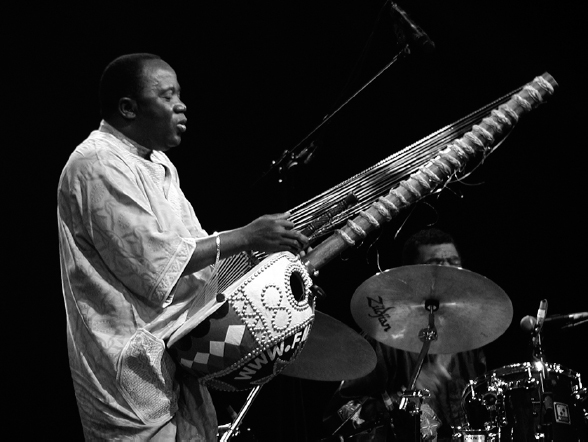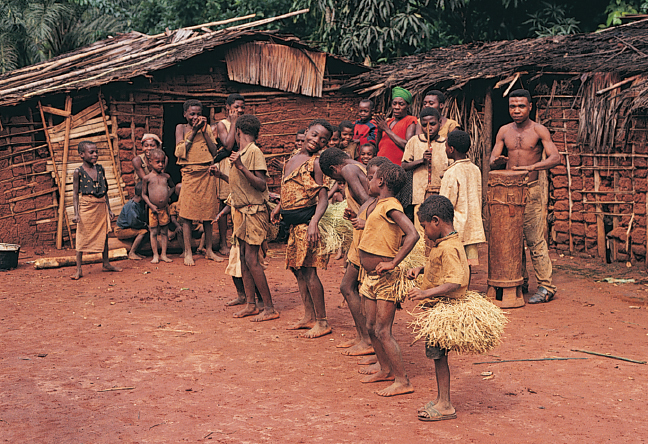Global Perspectives: African Ostinato Forms
African Ostinato Forms

Though we borrow the term ostinato from Italian Baroque music, the technique is much older than the seventeenth century and is dispersed around the globe. The organizational principle at stake is, indeed, basic: Set up a brief repeating musical unit and use it as the foundation for other, more varied melodies and harmonies.
Musical forms built according to this principle come in a wide variety of shapes and patterns. We have already appreciated one variety in “Dido’s Lament” by Purcell: a free-
Nowhere in the world is ostinato form more prominent, or practiced with a richer array of techniques, genres, and instruments, than in Africa. Up and down the continent, ostinato forms multiply in fascinating variety: from North and West African nations, with ancient traditions of troubadour-
The two examples of African ostinato forms heard here come from Gambia, a small nation lying along the West African coast, and from the Mbuti pygmies of therain forests of Congo in central Africa.
A Minstrel’s Song
In the Gambian excerpt, a singer-

In West Africa, singers to the kora often belong to guilds, with musical expertise passed down in families from generation to generation. Foday Musa Suso comes from such a family and guild. For centuries these singers have fulfilled a wide variety of social roles, singing the praises of patrons and rulers, narrating in song historical or legendary events, contributing to weddings and other celebrations, and — especially in recent times — simply providing informal entertainment. Their styles have also fed into recent developments in African pop music. In fact, Foday Musa Suso himself emigrated from Gambia to Chicago in the 1970s, where he made a name for himself playing music that fuses jazz, pop, and traditional African styles.
Our recording is an early one, from before Foday’s move, and offers a brief example of the kind of praise song a West African minstrel might sing for a wealthy patron. But our main point in introducing it is to sample an African ostinato form. After a short introductory flourish on the kora, Foday lays down an ostinato pattern, plucked mainly on the low-
Pygmy Polyphony
Since it was first recorded in the 1950s, singing in Mbuti pygmy communities has become famous for its delicate and complex polyphony. Pygmy polyphony is created in improvised group singing, sometimes in rituals central to the society, sometimes to accompany work, sometimes for simple pleasure and relaxation.
Pygmy polyphony involves a technique common to many kinds of African music: interlocking ostinatos. In a pygmy chorus, various voices form an intricate, repetitive texture by singing over and over again their own short melodic motives — often only one or two notes — in quick alternation. The overall effect is of a multistranded, hypnotically recycling ostinato. This choral ostinato can be savored on its own or else, as in our example, used as the foundation for freer melodies of lead singers.

A Hunting Song for Chorus
Two exclamations for the whole chorus announce the beginning of a song describing the bravery and daring of an elephant hunt. At first, we hear no clear ostinato. Instead, two lead singers alternate prominent melodic phrases while, underneath them, the chorus softly sings — almost murmuring — an indistinct, ostinato-
Then something marvelous happens. At about 0:44 the individual melodic motives of a polyphonic ostinato begin to crystallize in the chorus. We hear the polyphony taking shape. (How many distinct components of the ostinato can you make out?) By 1:30 the choral ostinato is fully formed and clearly articulated; it continues through to the end of the song (not heard here) underneath the soloists.
The singing is underlaid throughout by the simplest of instrumental accompaniments: two sticks struck together to mark the beat. The Mbuti rarely employ more elaborate instruments in their choral singing, though in other contexts they regularly play on drums, flutes, musical bows, and other instruments.
This song was recorded in the mid-